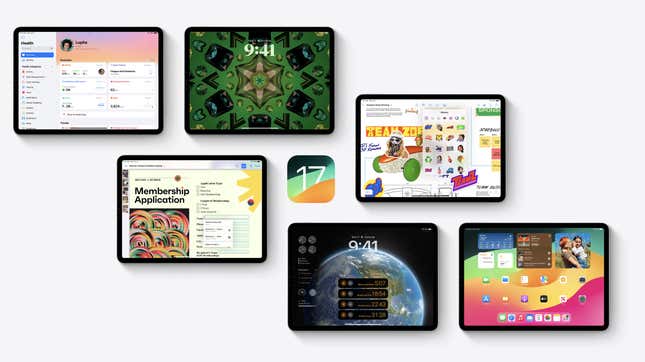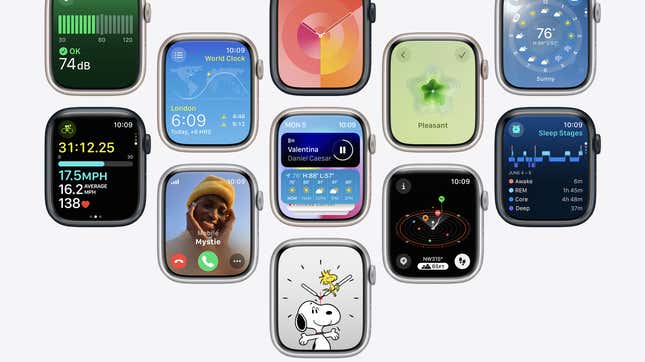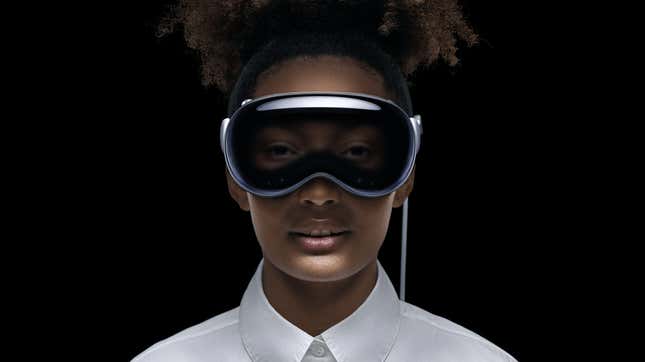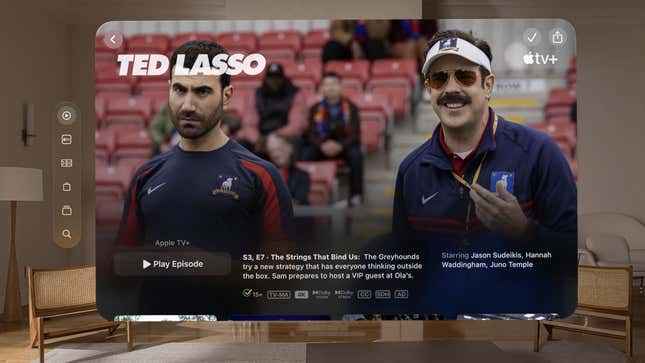This year’s WWDC is one for the history books. Apple made is usual software announcements, introducing iOS 17, iPadOS 17, macOS Sonoma, and watchOS 10, and even introduced the largest MacBook Air yet. However, the talk of the town won’t be the next iPhone update or the 15-inch MacBook Air: It’s definitely the new “Vision Pro” AR headset we’ve been hearing about for years. But let’s not get ahead of ourselves.
New Macs announced at WWDC
Table of Contents

Apple kicked off WWDC this year with new Macs, and kicking off that announcement was the reveal of the long-rumored 15-inch MacBook Air:
15-inch MacBook Air
It might sound like an oxymoron, but the 15-inch “Air” is real. It comes in at 11.5mm thin, weighing in 3.3 pounds, and comes with MagSafe charging, two USB-C ports, and in four colors, including recent additions Midnight and Starlight.
The new Air sports a 15.3-inch screen that can hit 500 nits of brightness, six speakers, a 1080p webcam, and Apple’s M2 chip. The company brags this iteration of the Air is 12 times faster than the “fastest” Intel-based MacBook Air, but those stats should always be taken with a grain of salt. Hopefully one stat that pans out is the Air’s 18-hour battery life, which would be more than enough to get you through an entire day of work and play.
The new 15-inch MacBook Air starts at $1,299 ($1,199 for education). It’s available to order today, and will be in stores next week.
Apple also cut the price of the 13-inch M2 MacBook Air by $100: It now starts at $1,099.
Pro Products
Apple then moved onto its pro Macs, starting with the Mac Studio. The new Studio now gets the M2 Max chip, which Apple says is 25% faster than M1 Max. But if that’s not enough power for you, you can buy a Mac Studio with the brand-new M2 Ultra: The chip connects two M2 Max dies together, with a 24-core CPU and up to 76-core GPU. Mac Studio has 8K display support, and can support six Pro Display XDRs.
But it’s not all about the smaller Mac Studio. Apple finally made a Mac Pro with Apple silicon. Specifically, any configuration of the new Mac Pro comes with M2 Ultra, with up to 192GB of unified memory. There are eight thunderbolt ports in total, two HDMI-ports, and six open expansion slots that you can customize with whatever supported cards you want. You can run 22 concurrent streams of 8K Pro Res video, a task that typically consumes a huge amount of processing power. It’s available in tower and rack-mount configurations, depending on how you need to store your Mac Pro.
Mac Studio starts at $1,999, while Mac Pro starts at $6,999. You can order both today, and both are available starting next week.
iOS 17
Moving on to iPhone, Apple introduced iOS 17. While it isn’t the most revolutionary update in iPhone history, it does add some great new features to the mix.
Updates to communication
Apple started with major updates to the Phone, FaceTime, and Messages apps: With iOS 17, we now have Personalized Contact Posters: These posters are sort of like your own customizable caller ID with the same editing engine as the Lock Screen: You pick an image of yourself and overlay your name, and this poster shows up whenever you call another iPhone.
Speaking of phone calls, Apple introduced Live Voicemail: This new feature displays a live transcription of a voicemail as it happened, providing easy call screening for all iPhones running iOS 17. You can take a peak and see whether that call is worth picking up, whether you’ll get around to it later, or whether it’s a spam call you can safely ignore forever.
On that note, Apple is adding video voicemail to FaceTime. Now, when you try to call someone on FaceTime and they don’t answer, you can leave them a video message filling them in on what they missed.
Messages gets a lot of new features
I’m really looking forward to Messages myself: This year, Apple is adding search filters, which lets you include additional terms to narrow down search results. Even better, there’s now a catch-up arrow that jumps to the first unread message in a thread. That will prove useful when you missed a lot of messages in the group chat. You can also swipe to reply on any chat bubble, a simple but efficient update. Also simple and efficient is that audio messages are now transcribed, so you don’t need to play the message to know what someone said.
Location sharing now appears in your conversations, but that isn’t the only location update. iOS 17 adds “Check In,” a new feature that helps your friends and family keep tabs on you when you’re on the move. When you start a Check In, your iPhone will automatically tell your chosen contacts when you get home. If it thinks you’re detouring from your route, it can share location and battery info with your friends to keep them in the loop. This feature, which is end-to-end encrypted, seems like a great way to stay safe.
Messages will look a lot cleaner now, too. A new Plus button hides away options like Camera, Photos, and iMessage apps, replacing the App Drawer. There’s also a brand new Stickers experience: When you tap the Plus button, then “Stickers,” you can see all your stickers at once. Also, all emoji are now stickers, and subjects you lift out of photos can now be stickers too. iOS saves a history of subjects you’ve lifted from photos so you can easily stick them to messages. You can also make live stickers out of Live Photos with effects. All of these stickers are now system-wide, so can add them in third-party apps as well.
AirDrop
AirDrop gets some new updates, too, for the first time in a while. Now, there’s NameDrop, which lets you share numbers or content with another iPhone just by bringing your devices close together. For numbers specifically, the transfer brings up your Contact Poster, and lets you choose phone numbers and email addresses you want to share. The feature works with Apple Watch, too. For the first time, you can leave AirDrop range before a transfer is done, and it’ll still work. Finally, you can bring phones together to enter SharePlay.
Apple improves autocorrect
Autocorrect now uses a new transformer language model for more accurate corrections. You can tap the underlined correction to revert back to original if it didn’t get it right. Best of all, the keyboard will learn from your corrections, so you won’t have to deal with “ducking” autocorrect all the time (Apple made that joke themselves, by the way).
Apple makes their own journaling app
“Journal” is an Apple-made journaling app that is deeply integrated with iOS. Journal uses on-device machine learning to make suggestions from your daily moments, like photos, location, music, workouts, etc, to generate entries for the day. You can customize what suggestions to include from this list. Journal includes writing prompts to help you get started with any given entry, too, and the entire experience is E2EE.
Turn your iPhone into a smart display
StandBy is a new feature that kicks in when you turn iPhone on its side while charging: When you do, a new full-screen display appears, displaying the time, weather, alarm, and more. StandBy lets you customize your displays with widgets or photos, and supports both Live Activities and Siri.
Siri gets some small but powerful changes
Speaking of Siri, you no longer have to say “Hey” to get her attention. Just say “Siri,” and the assistant will kick in. You can also run back-to-back commands now, so you can naturally ask a follow-up question after the first query to get a response.
Maps and Photos get two new features
As an aside, Apple also mentioned offline maps coming to Apple Maps, which will let you navigate areas when you have no service. Plus, the People album is improved in Photos, and can now recognize cats and dogs.
iPadOS 17

iPads this year gain many of the features Apple highlighted in iPadOS 17, but also have some updates of their own:
Widgets and Lock Screen
You can interact with widgets without opening the app itself, such as ticking off a to-do in a Reminder widget, controling lights in a Home widget, or playing songs from a Music widget.
In addition, iOS Lock Screen customizability comes to iPad. Machine learning adds a slo-mo effect to live photo wallpapers when waking your iPad. Rather than appearing underneath the time, Widgets run all along the side of the display, which lets you add more than you can on iOS. It also supports Live Activities.
Health
The Health app is now on your iPad: The app syncs across iPhone and Apple Watch, as well as third-party apps.
PDF improvements
With iPadOS 17, the system now identifies PDF fields, and supports auto-fill, which should make working in PDFs much easier than before. The Notes app also supports interacting with and annotating PDFs.
Stage Manager updates
Stage Manager, which brings macOS window manager to iPad, now adds more flexibility to window sizing and positions. Hopefully this means the feature works a bit better than before, and more like macOS than the odd hybrid we got in iPadOS 16. You can also now use the built-in camera on an external display when connecting your iPad to it.
Freeform
Apple’s digital whiteboard, Freeform, adds new drawing tools in iPadOS 17, and adds Follow Along, which lets you track collaborator activities.
macOS Sonoma

Like iPadOS 17, macOS Sonoma features some of the new features in iOS 17, but also some new features exclusive to Mac (although, granted, fewer than on either iOS or iPadOS).
To start, there are new screensavers, which sport slow motion video of places around the world. We also get support for widgets on the desktop: They’re interactive, too, like they are on iPadOS.
Gaming updates
Mac might not be known as a gaming platform, but Apple wants it to be: They’re adding a new “Game Mode,” which prioritizes CPU and GPU during bouts of gaming. The feature also reduces lag with wireless devices like headphones and controllers. Apple even collaborated with Hideo Kojima, who announced Death Stranding Director’s Cut will be coming to Mac soon.
Mac adds new video conferencing features
Apple is adding a new “Presenter Overlay” feature to the Mac. This option puts your video feed on top of your content: You can either be a small bubble over your work, or have the shared screen in the background like a poster. There’s also new reactions in video calls, similar to what you find in Zoom or Google Meet: You can even use gestures to activate reactions. These work in third-party apps, too, so you don’t need to settle for whatever effects your app offers.
Safari focuses on privacy
When you turn on private browsing in Safari in macOS Sonoma, it now locks your browser window behind authentication, so only you can return to a private session. The feature both blocks trackers and removes tracking from URLs.
You can also now securely share Passkeys with close group of contacts under a feature called Family Passwords. This is also E2EE. We have Profiles for the first time on Safari, so you can separate your work from your personal browsing. Plus, you can add websites to the dock to turn them into web apps, regardless of whether or not the developer made the site a web app in the first place.
Audio & Home
Apple announced Adaptive Audio for AirPods, which blends Transparency and Noise Cancellation together at the same time. This feature reduces loud noises while letting you hear what’s around you. When you start speaking, for example, your music lowers and the AirPods focus on who you’re talking to. When on a call, it reduces noise around you. And automatic switching is faster when moving between devices.
AirPlay now learns your preferences, so it queues up the right audio output for a new play request. Apple also announced “AirPlay in Hotels:” Scan a QR code on your hotel TV, tap confirmation, and you’ll be able to AirPlay to the hotel TV, no wires or payment required.
Finally, car passengers can AirPlay their music through CarPlay, so anyone can pass the metaphorical aux.
tvOS and Apple TV
Apple didn’t make many new announcements here, but they did mention the following: tvOS 17 has a new Control Center design, and you can now use your iPhone to find your lost Apple TV remote. Plus, you can see your photos as a TV screensaver.
The biggest announcement, however, is FaceTime on Apple TV: It connects to your iPhone or iPad, and uses Continuity Camera and Center Stage to let you have FaceTime calls on your TV.
watchOS 10

WatchOS 10 is made up of a bunch of small features this year. To start, there’s a new Smart Stack watch face. This face is organized chronologically, so you can scroll ahead to see what’s on your plate later on in the day.
Small changes
World Clock now has colors to reflect time of day, so you can easily tell what time it is in a different city; the Activity app now has corner icons; and Snoopy and Woodstock now have a cute watch face. They’re featured in different scenes, including one that reacts to current weather locations. If it’s raining in your location, it might just be raining on Snoopy, as well.
Workouts
The Cycling workout now connects to Bluetooth bike accessories, and can estimate your FTP, the highest level of intensity you can maintain for an hour. The app estimates power zones to help with your training, and Cycling workouts show up as Live Activity on your iPhone.
A Hiking workout shows your last-known location, and shows where on your route you can make an emergency call. You can use search to look for new trails nearby, which shows details about each—helpful if you’re looking for a particular length of time or difficulty.
Health
A new Mental health option helps you visually identify how you’re feeling throughout the day. This feature works on iPhone as well, if you don’t have an Apple Watch. Plus, you can take standardized screening tools to see if you’re suffering from something like depression or anxiety.
Apple is also hoping to help improve vision health, as well. Your Apple Watch tells you if your child is spending enough time outside in daylight: The company talked about how a lack of sunlight is a leading cause of myopia, and this feature could help promote more sun exposure. In addition, there’s a new Screen Distance alert that will warn you if you’re using your iPhone or iPad too close to your face.
All of the new software versions have a developer beta out today. The public betas for each will arrive in July, and all release in the fall.
For more on this, here are the 10 best new watchOS features announced today.
Vision Pro

The tail end of the presentation focused on Apple’s long-rumored new headset, Vision Pro, which brings a classic Apple experience into augmented reality (AR). While the headset completely covers your eyes, the cameras bring your room into full view, overlaying your content onto the real-world. It’s like something out of Iron Man or Terminator.
Vision Pro runs a new operating system called visionOS, which essentially combines iPadOS and macOS into AR. The windows and elements actually respond to light and cast shadows to enhance the illusion. You can scale any app as large or small as you want, wherever you want in the space.
You also don’t need to stay in your current space: Environments bring different scenes into your room, like a forest or beach background. These backgrounds aren’t like Zoom backgrounds: They’re incredibly high-quality, and can be a small part of your room, or completely take over the space.
Apple designed Vision Pro to be used with just your eyes, hands, and voice, no need for controllers like you find on the Meta Quest. You look at icons to highlight them, tap your fingers to select, and flick to scroll. That said, you can use keyboards, trackpads, Mac, and more to complement the experience. A Mac brings in a 4K display into the experience.
While Vision Pro looks like a pair of ski goggles with a screen that blocks your face, Apple hopes other people in the room will be able to chat with you without issue. That’s because the front screen shows a visual representation of your eyes in a feature called “Eye Sight.” Eye Sight creates the illusion that people can look you in the eye while you’re wearing the headset. Your eyes only appear when someone is in your space, too. Otherwise, it’s just a blank screen.
If nothing else, Vision Pro seems perfect for entertainment. You can watch your shows and movies on a giant floating screen in your room, dim the environment, place yourself in a “movie theater,” bring in other Environment, and even watch 3D movies. Disney’s Bob Iger advertised its vision of Vision Pro: You can Watch The Mandalorian on Tatooine, or watch a football game “at the game.”

Of course, the same benefits apply to gaming, as well. Apple says there will be over 100 Arcade titles to play when Vision Pro launches, but hopefully we finally see some more major games appear on Apple’s platform now.
Vision Pro’s design
Vision Pro shares the same design language as AirPods Max, sporting a digital crown and long power button. The headset has audio built in, but not as headphones: These audio outputs rest of the sides of your head, rather than over or in your ears. However, it does support wireless earbuds like AirPods. Like an Apple Watch, you can change out the band to find the right one to fit your head, and for those of us who wear glasses, there are Zeiss inserts to accommodate our frames.
Vision Pro performance
Vision Pro has some impressive hardware. The internal displays are micro OLED, and fit 64 pixels in the space of a single iPhone pixel. There are 23 million pixels in total across both screens. The built-in audio matches the sound to your room to create the illusion that the sound is happening in your space.
The headset has an M2 chip built-in, but also a new R1 chip which handles the cameras, sensors, and microphones. There’s an internal cooling system to keep things from getting too hot, but that won’t help you when it comes to battery life: There’s only two hours of use with the on battery attachment, but the headset can be plugged in to external power for all-day use.
You can FaceTime with this thing, but obviously, there’s no way to properly capture your face during the call. So, there’s a feature that lets you scan your face, and creates a digital version of yourself from the scan. It’s a step up from a Memoji or a character in Meta’s metaverse, but it is a bit odd.
Don’t think people will be able to steal your headset and use it for themselves, either: Vision Pro authenticates with a new feature called Optic ID, which scans your irises rather than your face to unlock. Wild.
As you might guess, a headset like this costs a lot. Apple is pricing the headset at $3,499, and is making it available early next year.
